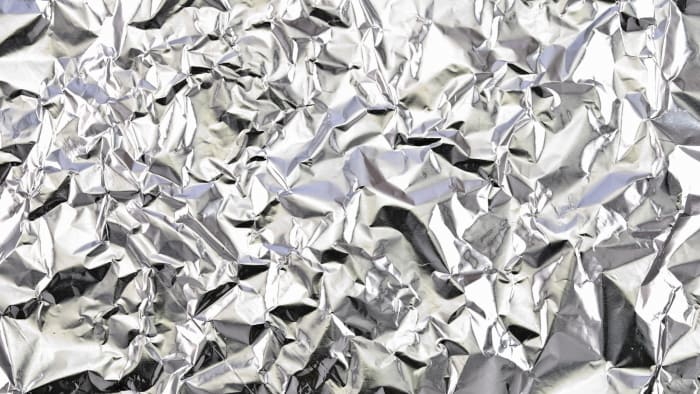The reaction of aluminum with hydrogen and other substances
Chemical properties of the most common metal
Aluminum is an active metal, which is stable in air, and quickly oxidizes at a normal temperature, gaining a dense film of oxide, which protects the metal from further damage.

Interaction of aluminum with other substances
In ordinary conditions, water does not affect this metal even in a boiling state. If the protective oxide film is removed from the surface of the aluminum, the metal enters into a vigorous interaction with the water vapor in the air, turning into a crumbly mass of aluminum hydroxide with release of hydrogen and heat. The equation of the reaction is:
2Al + 6H₂O = 2Al(OH)₃ + 3H₂

If the protective oxide film is removed from aluminum, the metal enters into a vigorous interaction with oxygen. The aluminum powder burns, forming oxide. The equation of the reaction is:
4Al + 3O₂ = 2Al₂O₃
This metal also interacts actively with many acids. In a reaction with hydrochloric acid, release of hydrogen is observed. The equation of the reaction is:
2Al + 6HCl = 2AlCl₃ + 3H₂
In ordinary conditions, the concentrated nitric acid does not interact with aluminum, as nitric acid, as a strong oxidizer, makes the oxide film even stronger. For this reason, nitric acid is stored and transported in aluminum containers.

Aluminum at an ordinary temperature is passive to diluted nitric and concentrated sulfuric acid. In hot sulfuric acid, the metal dissolves, and the equation of the reaction is:
2Al + 4H₂SO4 = Al₂(SO4)₃ + S + 4H₂O
Interaction of aluminum with non-metals
It reacts with halogens, sulfur, nitrogen, carbon and all non-metals. For the reaction, heat is required, after which interaction takes place with the release of a large amount of heat.
Interaction of aluminum with hydrogen
Aluminum does not directly react with hydrogen, although there is a solid polymeric compound, alane, in which so-called three-center bonds exist. At a temperature of over 100 degrees Celsius, alane irreversibly breaks down into simple substances. Aluminum hydride reacts vigorously with water. Aluminum does not react with hydrogen directly — the metal forms compounds, through the loss of electrons, which are received by other elements. The hydrogen atom does not receive electrons, which metals give to form compounds — hydrogen atoms can only be “forced” to accept electrons with the formation of solid ionic compounds (hydrides) by very reactive metals (potassium, sodium, magnesium, calcium). The direct synthesis of aluminum hydride from hydrogen and aluminum requires enormous pressure of around 2 billion atmospheres and a temperature of over 800 K. Here you’ll find out about chemical properties of other metals.
We should note that hydrogen is the only gas which significantly dissolves in aluminum and its alloys. The solubility of hydrogen changes in proportion to the magnitude of temperature and the square root of pressure. The solubility of hydrogen in liquid aluminum is significantly higher than in solid aluminum; this property changes insignificantly depending on the chemical composition of alloys.
Aluminum and its hydrogen porosity

The formation in aluminum of hydrogen bubbles depends directly on the speed of cooling and hardening, and also the presence of centers of formation for the release of hydrogen — oxides trapped inside the alloy. For aluminum to become porous, the content of dissolved hydrogen must significantly exceed the solubility of hydrogen in solid aluminum. If there are no centers of formation for the release of hydrogen, a relatively high concentration of the substance is required.
The location of hydrogen in hardened aluminum depends on the level of its content in liquid aluminum and the conditions in which the hardening took place. As hydrogen porosity is the result of mechanisms of formation and growth, controlled by diffusion, such processes as a reduction in the concentration of hydrogen and an increase in the speed of hardening suppress the formation and growth of pores. For this reason, aluminum that is cast using the split mold method is more liable to defects connected with hydrogen than aluminum that is cast under pressure.
There are different sources for hydrogen to enter aluminum.
Melting stock — scrap metal, ingots, foundry returns, oxides, sand and lubricants used in mechanical processing. These pollutants are potential sources of hydrogen formed in the chemical breakdown of water vapor or the reduction of organic substances.
Melting tools — scrapers, pikes and spades are a source of hydrogen. Oxides and the remains of fluxes on tools absorb moisture from the surrounding air. Furnace bricks, distribution channels, ladles for selecting samples, lime chutes and cement solutions are potential sources of hydrogen.
The stove atmosphere — if the melting furnace runs on oil or natural gas, there may be incomplete combustion of fuel with formation of free hydrogen.
Fluxes are hydroscopic salts capable of absorbing water instantly. For this reason, a moist flux inevitably adds hydrogen to an alloy, which is formed in the chemical breakdown of water.
Foundry molds — in the process of filling a foundry mold, liquid aluminum flows turbulently and captures air inside it. If the air does not escape from the mold before the aluminum starts to harden, aluminum will enter the metal.